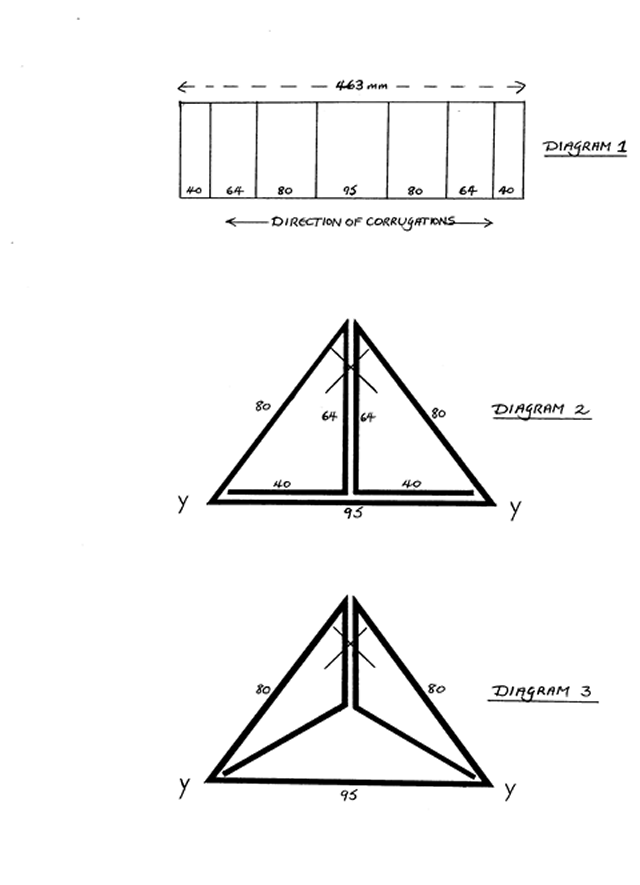|
Make A Stand !
A model yacht is a graceful and elegant thing on the water, but a clumsy
and awkward thing out of the water, so a stand is a very useful accessory,
making it much easier to store or display the yacht, or to carry out
work on the rig.
Messrs Star Productions used to make a simple corrugated-cardboard
stand for their yachts. These stands are very easy to reproduce. Making
one takes about half an hour and the cost is negligible.
This stand is suitable for any yacht which has a flat sheet-steel fin
such as Star, Bowman, Sea Rover, and no doubt many other makes.
The first thing to do is to obtain some suitable corrugated cardboard.
All of the stands made so far have been made from corrugated cardboard
about 2.5 mm thick from boxes which contained Ikea or MFI flat-pack
furniture. If thicker material is used, it might be necessary to adjust
the measurements given below by a millimetre or two.
In order to ensure that the cardboard folds up neatly and squarely,
it is necessary to mark out and score it as accurately as possible.
The side of the cardboard that is marked out and scored will end up
on the inside of the stand. Therefore if the piece of cardboard has
a good side and a less-good side, mark out on the less-good side.
Mark out on the cardboard a rectangle measuring 463mm long parallel
to the corrugations, by a width across the corrugations that is about
30mm bigger than the width of the yacht's fin at a point 66mm from the
bottom of the fin. When making stands for Star yachts, the following
measurements are suitable for the width of the rectangle.
SY1, 100mm. SY2 and Endeavour 1, 120mm.
SY3and Endeavour 2, 140mm.
SY4, 175mm. Endeavour 3, 165mm. (The fins are not the same.)
SY5 and Endeavour 4, 175mm. SY6 225mm. SY7, 270mm.
Mark lines across the width of the rectangle to divide the length of
it into sections of the following sizes.
End, 40mm, 64mm, 80mm, 95mm, 80mm, 64mm, 40mm, end. Total 463mm.
The shape marked out will look like diagram 1 below.
Cut around the 463mm by whatever-width-used rectangle. Score the lines
across using a ruler and the back of a table knife at a small angle
to the surface. The idea is to crush the corrugations without cutting
through the surface layer. The cardboard will easily fold along the
scored lines to produce the cross-section shown in diagram 2, but without
the gaps shown for clarity.
Star Productions provided a special clip like a large hairclip to hold
yacht and stand together, but two large paperclips are an effective
substitute. A paperclip is pushed onto each end of the stand at point
X on diagrams 2 and 3. The 100mm stand utilises one 50mm and one 75mm
paperclips, and the larger stands utilise two 75mm paperclips.
The paperclips require some modification. Bend the cut ends away from
the cardboard so that they will not dig into it when the paperclips
are being removed. It will be apparent that the paperclips are not intended
to accommodate something as thick as the two thicknesses of cardboard
with the fin between. However, after some thought it will be clear how
to bend and adjust the paperclips so that they can better accommodate
this thickness.
It is not possible to just drop the yacht onto the stand. The stand
must be fitted onto the fin by pulling the paperclips out, pushing the
stand onto the fin and then pushing the paperclips back in again. The
stand is then placed on a flat surface and pushed down by the ends projecting
in front of and behind the fin, to square it up so that the base is
flat. Finally the fore-and-aft angle of the yacht is adjusted.
If a stand is required for a very small yacht, and it is thought that
one made to the above dimensions will be too big, a smaller stand may
be made to the following dimensions.
End, 24mm, 41mm, 52mm, 62mm, 52mm, 41mm, 24mm, end. Total 296mm.
It is possible to modify the design of this stand in order to accommodate
yachts having an additional weight on the bottom of the sheet-steel
fin, by adjusting the measurements to produce the cross-section shown
in diagram 3. The following measurements will produce a stand of this
cross-section.
End, 54mm, 30mm, 80mm, 95mm, 80mm, 30mm, 54mm, end. Total 423mm.
Note that an important part of the rigidity of the stand is provided
by the ends of the cardboard fitting into the angles at points Y in
diagrams 2 and 3.
If it is desired to decorate the stand by painting it or by sticking
paper onto it, such treatment should probably be given to both sides
of the cardboard in order to avoid warping it.
Thanks to Messrs Star Productions for devising the stand, and to VMYG
member Trevor Smith for showing it to me.
Nigel Hancock
January 2006

|
